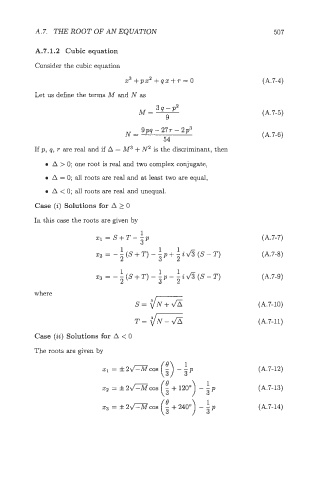Page 527 - Modelling in Transport Phenomena A Conceptual Approach
P. 527
A.7. THE ROOT OF AN EQUATION 507
A.7.1.2 Cubic equation
Consider the cubic equation
x3 + p x2 + q x + r = o (A. 7-4)
Let us define the terms M and N as
&f=- 3q--p2 (A.7-5)
9
9pq - 27r - 2p3
N= (A.7-6)
54
If p, q, r are real and if A = M3 + fl is the discriminant, then
0 A > 0; one root is real and two complex conjugate,
0 A = 0; all roots are real and at least two are equal,
0 A < 0; all roots are real and unequal.
Case (i) Solutions for A 2 0
In this case the roots are given by
1
xl=S+T--p (A.7-7)
3
22 =--(S+T)-p+:ifi(S-T)
1
1
2 2 (A.7-8)
1 1 1
x3 = - - (S +T) - -p - - i fi (S - T) (A.7-9)
2 3 2
where
S= $v+a (A. 7- 10)
T= VN-~ (A. 7- 11)
Case (ii) Solutions for A < 0
The roots are given by
(A. 7- 12)
x2 = f2GiTcos (A. 7- 13)
23 = f2mc0s (A. 7- 14)

